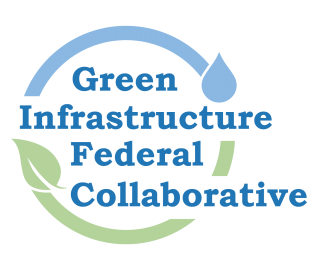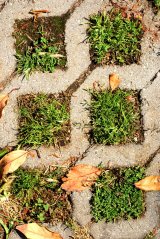Green Infrastructure Federal Collaborative

In May of 2021, EPA launched the Green Infrastructure Federal Collaborative. This cooperative effort fosters engagement and cooperation between agencies that actively work to promote the implementation of green infrastructure.
Collaborative members work closely to align knowledge and resources to build capacity for green infrastructure implementation. These coordinated efforts provide a platform to publicize the multiple environmental, economic, and social benefits of green infrastructure. In addition, the collaborative seeks to facilitate strategies that foster community livability and encourage the implementation of green infrastructure in all communities.
On this page:
- Background
- Federal Funding Resources
- Federal Permitting
- Past Collaborative Webinars and Events
- Collaborative Members
Background
The Water Infrastructure Improvement Act of 2019 (pdf) sparked the formation of the federal collaborative by directing EPA to coordinate efforts with federal, state, tribal, and local governments to increase the use of green infrastructure, providing an impetus for collaborative efforts to continue to evolve. Although EPA primarily uses the term "green infrastructure" as defined under the Clean Water Act, other government and nongovernmental organizations use other terms to describe the similar nexus of nature and man-made systems:
- nature-based solutions
- engineering with nature
- natural infrastructure
- green stormwater infrastructure
- low-impact development
EPA defines nature-based solutions as actions that protect, conserve, restore and sustainably manage natural or modified ecosystems. They use natural features or processes to address public health and environmental challenges while providing multiple benefits to people and nature. Visit the Green Infrastructure Resources page for other EPA programs that promote these types of solutions.
As nature is seen as a critical infrastructure that provides fundamental services to protect human health, and restore our ecosystems, the use of "nature-based solutions" across federal programs is common. Nature-based solutions can encompass a wide range of actions that may include planning, design and maintenance of engineering practices that restore, use or enhance natural processes (e.g. green infrastructure, agricultural conservation practices, coastal restoration) and/or protect natural features to preserve ecosystem function (e.g., wetlands, forests, riparian areas, coral reefs).
In 2023, FEMA and EPA updated a Memorandum of Agreement (MOA) to work together on several fronts including conducting benefit analyses of nature-based solutions for building long-term resilience.
The U.S. Army Corps of Engineers has an initiative, Engineering With Nature®, to align processes of nature with engineering to provide more sustainable delivery of economic, social and environmental benefits associated with infrastructure.
The Department of Interior released a Nature-Based Solutions Roadmap (pdf) to provide staff with consistent and credible information about nature-based solutions, such as what benefits they are likely to provide, example projects, and additional resources for project planning, construction, and monitoring.
Federal Funding Resources
Navigating Federal Funding for Green Infrastructure and Nature-Based Solutions Table
The Green Infrastructure Federal Collaborative understands that one of the barriers accessing federal funding is the complexity of navigating the available opportunities. To support communities, the Collaborative compiled and periodically updates the Navigating Federal Funding for Green Infrastructure and Nature-Based Solutions (pdf) table, which is a comprehensive list of green infrastructure federal funding opportunities.
Common Terms
When applying for federal funding and technical assistance it is important to understand which terms are specified in each Notice of Funding Opportunity or Request for Applications. Below are examples of various terms Green Infrastructure Federal Collaborative members use.
| Agency | Used Term(s) |
|---|---|
| FEMA | Nature-Based Solutions |
| U.S. Army Corps | Engineering with Nature and Nature-Based Solutions |
| USDA | Conservation, Urban Forests and Restoration Practices |
| Department of Defense | Nature-Based Solutions and Natural Infrastructure |
| Housing and Urban Development | Green Infrastructure |
| General Services Administration | Green Infrastructure |
| Department of State | Green Infrastructure |
| EPA | Green Infrastructure, Nature-Based Solutions and Low Impact Development |
| NOAA | Green Infrastructure and Coastal Restoration |
Department of Defense Readiness Project Funding Guide
On April 11, 2023, the U.S. Department of Defense Readiness and Environmental Protection Integration Program (REPI) (pdf) released the 2023 Readiness Project Funding Guide (pdf).
In coordination with federal agencies of the Green Infrastructure Federal Collaborative, REPI created a guide that provides 27 funding programs for nature-based solutions to improve communities and military installations. It contains a calendar, descriptions, eligibility requirements, and application information for each funding program. It also aligns each program with hazard categories: Drought, Wildfire, Coastal Hazard, Riverine Flooding, and Land Degradation.
Federal Permitting
The GIFC developed this guide to identify ways to accelerate federal permitting and environmental reviews for nature-based-solutions (NBS) projects. This document is intended to provide federal agencies involved in the review of NBS projects with an overview of the federal permitting and environmental review processes related to NBS implementation; best practices recommendations; and examples of NBS projects and successful federal agency permitting networks that have navigated and streamlined these reviews and processes.
Past Collaborative Webinars and Events
Quick links:
- Navigating Federal Funding for Green Infrastructure and Nature-Based Solutions
- American Association for the Advancement of Science Federal Convening on Green and Nature-Based Infrastructure
Navigating Federal Funding for Green Infrastructure and Nature-Based Solutions
During this webcast, members of the Green Infrastructure Federal Collaborative discussed funding and technical assistance opportunities that advance the implementation of green infrastructure and nature-based solutions. Attendees learned how federal programs are helping build vibrant communities with programs that support designing, constructing, and maintaining green infrastructure. Breakout sessions hosted by Collaborative members provided attendees with the opportunity to pose questions and interact directly with relevant federal agencies.
November 2, 2021
Webcast Materials: Presentation Slides (pdf) and Master Summary of Funding and Technical Assistance Opportunities (pdf)
Speakers
- Federal Emergency Management Agency
Charley Carson, Bradley Dean, Josh Human, Sarah Watling - National Oceanic and Atmospheric Administration (NOAA)
Matt Chasse - Natural Resources Conservation Service
Russel Ames, Kevin Farmer - U.S. Army Corps of Engineers
Mindy Simmons - U.S. Department of Housing and Urban Development
Jorge Morales, B. Cory Schwartz, Seema Thomas - U.S. Economic Development Administration
Naomi Friedman - EPA
Jacob Burney, Robyn DeYoung, Ellie Flaherty, Karen Fligger, Wynne Miller, Michael Goralczyk, Samantha Rachko, Santina Wortman
AAAS Federal Convening on Green and Nature-based Infrastructure
To learn about the information presented during the two-day convening, discussions held, and key resources identified by participants, view the summary of key takeaways (pdf).
The American Association for the Advancement of Science's Center for Scientific Evidence in Public Issues hosted a convening for federal employees and contractors working on green and nature-based infrastructure. Attended by representatives from 12 federal agencies and planned in collaboration with the EPA Office of Water's green infrastructure staff, the convening discussions focused on identifying successful models, lessons learned, data gaps, challenges and barriers, and opportunities for collaboration.
November 9 and 10, 2021
Event information, key issues, and participating agencies.
Collaborative Members

Participating federal departments and agencies are committed to promoting green infrastructure through their work. Current collaborative members include:
- American Association for the Advancement of Science
- Executive Office of the President, Council on Environmental Quality
- U.S. Agency for International Development
- U.S. Department of Agriculture
- Natural Resources Conservation Service
- U.S. Forest Service
- U.S. Department of Commerce
- National Oceanic and Atmospheric Administration
- U.S. Economic Development Administration
- U.S. Department of Defense
- U.S. Department of the Army
- U.S. Department of the Navy
- U.S. Army Corps of Engineers
- U.S. Department of Energy
- U.S. Department of Homeland Security
- Federal Emergency Management Agency
- U.S. Department of Housing and Urban Development
- U.S. Department of the Interior
- U.S. Fish and Wildlife Service
- National Park Service
- U.S. Department of State
- U.S. Department of Transportation
- Federal Highway Administration
- U.S. Environmental Protection Agency
- U.S. General Services Administration
- U.S. Global Change Research Program
- U.S. Millennium Challenge Corporation
- World Health Organization
Is your federal agency interested in working with the Green Infrastructure Federal Collaborative? Contact Robyn DeYoung at deyoung.robyn@epa.gov to discuss opportunities.
